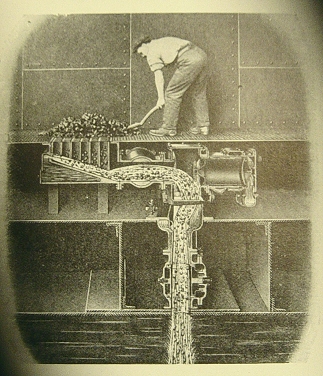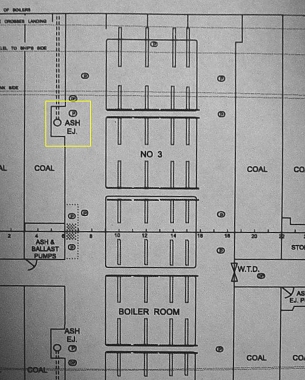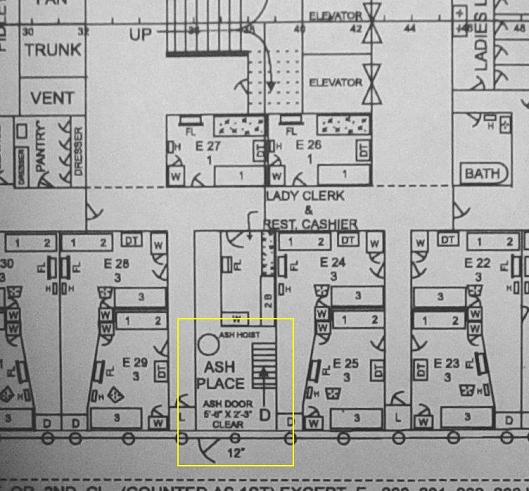![]()
![]()
TRMA Tech Feature of the
Month
October 2005
Ash Ejectors
The Olympic-class ships consumed, on average, 650 tons of coal each day. Even with the most efficient firing possible, a great deal of ash resulted - over 100 tons a day. Since the stoking floors were several decks below the waterline, an efficient means had to be employed for disposing of such large quantities of ash.
The device employed was the See's Ash Ejector. There were two in each large boiler room (2 through 6), recessed into the coal bunkers at various locations. To dispose of the ash raked from the furnace, a trimmer would fill a barrow and wheel it over to the nearest ash ejector, which consisted of a large grating over a hopper that was slightly above the level of the stokehold floor. The ashes were discharged by shoveling them into the hopper, where they then were drawn down by the rush of air to a water jet which was being discharged through a long inclined pipe, at a pressure of about 150 lb., being maintained by a large duplex feed pump. The water jet carried the ashes up the inclined pipe till, at the upper bend they were deflected and discharged well clear of the ship's side above the water line.
The contemporary drawing below left shows an ash ejector in use, although
it illustrates a different type than used on the Olympic and Titanic.
The one shown is similar to that used on vessels such as the Britannic and
Aquitania, which ejected the ashes straight down under the hull rather than
out to the side of the ship. The principle is the same, however. The plan
detail below right shows the location of the ash ejectors in one of Titanic's
boiler rooms. The next figure illustrates a section of one of Olympic and
Titanic's boiler rooms with the See's ash ejector in view.


While in pilotage waters, the
ash ejectors could not be used as per regulation. Among other issues cited
by the authorities at the time, the ashes were ejected some 20-30 feet from
the side of the ship, and would surly inundate passing craft or the wharf
with filth if the ejectors were used. When in port, the number one boiler
room was used for powering the auxiliaries, and was subsequently not fitted
with ash ejectors. For port use, four Railton, Campbell & Crawford ash
hoists were employed. At each ash hoist, the ash was shoveled into canvas
bags, and mechanically hoisted through a shaft to a room called the Ash Place
on E-Deck for later disposal.

Details from General Arrangement plans courtesy Bruce
Beveridge. Copyright 2004 Bruce Beveridge.
A full set of these plans is available for purchase -
click here.
Have a question on this item? Post it on the TRMA Titanic Forum.
Copyright ©2005 Titanic Research & Modeling Association